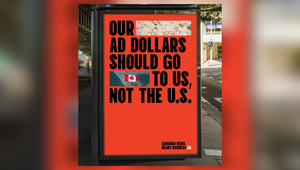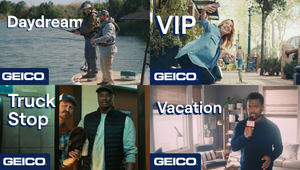
Can Brands Sell Love in 2025?

Allow me to start with a bleak idea: Perhaps we’re all a bit tired of love, or more specifically dating? Maybe I’m projecting, but it’s starting to look like self care equates to self love – something that is taking centre stage, or at least, has been on its way for a while now.
Brands are onto that, but they also need to sell us fast dating that’s meant to end in a life-long romance. Love in marketing has been a digital rollercoaster, full of shiny moments, carefully curated meet-cutes, and meticulously edited stories. Sure, it makes us feel warm and fuzzy inside. But if we scratch beneath the surface of these perfect depictions of modern romance, we have to ask, ‘what are we really searching for when it comes to the ‘look of love’?’. Is love an emotion you can sell, even? In a world where every swipe, like, and match is carefully crafted, what do brands actually need to offer to stay relevant in a post-pandemic, war-torn, economically stressed, tech-saturated dating world?
The Swipe Era: Tinder's Vibrant but Unrealistic Promise
Take Tinder’s vibrant ‘It Starts with A Swipe’ campaign. It's glossy, it's colorful, and it promises us a world of infinite possibilities. The campaign has the ‘endless choices’ vibe, where one simple swipe could lead to a lifetime of love or a wild adventure.
Yet, despite its glitz, there's something a little too packaged about the whole thing. "We were inspired by how a match can launch into any one of those outcomes," says Bianca Guimaraes, ECD at Mischief, the agency behind the campaign. And yes, maybe that’s the reality for some – an app-driven love story full of potential. But for many, this high-energy marketing feels more like a daydream than an actual possibility.
A quick glance at recent trends reveals more. "Dating in 2025 is being largely shaped by economics and technology," says Joanna Allcock, brand and client development lead at youth marketing agency Seed. With the cost-of-living crisis hanging over millennials and gen z, traditional romantic milestones like moving in together are being delayed, making cohabitation feel more like a financial decision than a romantic one. Add to that the transactional nature of dating apps – gamified swiping, paradoxes of choice, and a certain fatigue that comes with endless options – and it’s easy to see why many young daters are taking a step back.
Do Zoomers Want More Than Cheap Thrills?
Gen z, in particular, is rewriting the rules of romance. "They are more selective and pragmatic, balancing financial realities with a desire for genuine connections," says Joanna.
This is apparently the cohort that’s not looking to settle down quickly, nor are they swiping for sport. Instead, they want something real – something intentional. As a result, the search for love has shifted from the screens of dating apps to more organic, real-life experiences.
Forget swiping from your couch; now it's all about pottery classes, yoga workshops, and coffee tastings. As we speak, the restaurant I live above is holding a real life blind dating event! "Community-focused experiences," as Joanna describes it, are becoming the new dating spaces. It's a move toward shared, authentic connections – not just romantic ones.
And that’s where Bumble’s latest campaign comes in, with a more refined take on user experience. The app’s new features, like incognito mode and advanced matching filters, give users more control over their privacy and the connections they want to make.
It's Tinder’s more thoughtful, introspective cousin, offering users the ability to curate their interactions based on shared values and interests.
But that’s not to say the brand gets it right every time. Bumble recently found itself in hot water over its controversial anti-celibacy stance, which framed abstinence as something to avoid at all costs. It was an odd misstep for a brand that’s been positioned as supportive and empowering, especially for women. In an era where more people are taking their time with relationships (and not just rushing into them for the sake of a status update), the idea that celibacy is something to ‘overcome’ didn’t sit well with many. Which leads us to my next point.
The Celibacy Controversy: What It Says About Lovers’ Expectations
The controversial ads featured messages like, ‘A vow of celibacy is not the answer’, and ‘Thou shalt not give up on dating and become a nun’, sparking outrage for shaming women who are choosing to be sexually inactive. But, with Trump’s re-election, highly publicised femicides around the world, and a collective shift in consciousness, more women are actually joining the celibacy movement.
Bumble’s apologies were swift, but the damage was done. Critics, including model and actress Jordan Emanuel, called the campaign “tasteless”, and criticised it for undermining women’s autonomy over their bodies. After all, Bumble’s ethos has long been about empowering women to make their own choices – and this campaign clearly missed the mark.
In hindsight, the controversy says a lot about what today’s dating app users want and need. Consumers – especially women – are increasingly vocal about their right to choose how and when they engage with intimacy.
As the boundaries of what constitutes ‘healthy’ dating continue to shift, brands that fail to respect those choices risk alienating the very audience they’re trying to engage. Bumble’s attempt to inject humor into what it saw as a ‘frustrated dating community’ backfired because it failed to acknowledge the obvious.
As Joanna notes, “Gen z isn’t rejecting love – they’re just rewriting the rules.” The newest generation of daters isn’t simply following the rules of the past; they’re carving their own paths. This means brands have to move away from portraying love as one-size-fits-all, especially when it comes to gendered expectations or stereotyped narratives. The backlash against Bumble’s campaign is a stark reminder that love, and the way it’s marketed, is not a one-way street.
Sex, Self-Love, and Empowerment: What Lovehoney Teaches Us About the Look of Love
A recent Lovehoney campaign, while humorous, also served a purpose: advocating for sexual wellness, inclusivity, and the dismantling of shame around intimacy. The brand used the campaign to highlight the fact that many people (41% of Brits, according to Lovehoney’s research) are using household objects in place of actual sex toys, often risking their health in the process. By incorporating in-house experts to provide insights, Lovehoney connected with consumers on a more authentic level, emphasising the importance of sexual health and self-care.
This angle of authenticity – championing self-love while making space for humour and defiance of taboos – aligns with a larger trend in marketing today. It’s not about shying away from what’s uncomfortable. It’s about embracing those subjects with a balance of respect and humour. Lovehoney’s defiance against advertising restrictions worked because it tapped into something that consumers really crave: being real for once.
Lou Kelly, head of consumer at Boldspace, notes that the campaign’s “fighting back” spirit resonated with audiences who appreciated the brand’s willingness to push boundaries and promote a sex-positive message.
In a world increasingly concerned with censorship and self-expression, Lovehoney’s creative strategy speaks volumes about consumers’ need to embrace intimacy, say it with me, on their own terms. Free from shame, free from judgement.
The New Reality: Real-Life Connections Over App-Driven Romance
So, this rush to connection feels increasingly out of step with what people are looking for in 2025. When it comes to relationships, they’re no longer seeking instant gratification. Instead, there’s a growing desire for depth, meaning, and moments that don’t feel rushed or commodified.
“The biggest mistake is assuming gen z approaches relationships like previous generations,” says Joanna. These aren’t the days of ‘I want it all, and I want it now’. People want to know who they're connecting with, and why. And that means being more selective, rather than simply swiping for the fun of it.
As much as brands try to sell us ‘the look of love’, what consumers are really yearning for is authenticity, and not just in romantic connections. Gen z’s desire for genuine connection extends beyond the realm of dating, into friendships, community, and self-discovery.
Brands that understand this shift and reflect it authentically will be the ones to forge real emotional connections.
The Future of Love in Marketing: Moving Beyond the Digital Bubble
We see this reflected in the strategy of Six+One, a brand that successfully wove familiar dating app experiences into its user interface and campaign. ‘Love’ was the core concept in its approach, but it wasn’t just about matchmaking. Its marketing created a more holistic experience – one that mirrors the shifting expectations of today’s lovers.
If dating apps are to keep in line with what gen z (and gen alpha later on) really want, they’ll need to go beyond the traditional matchmaking model. In a world where love is less about instant swipes and more about slow-burn connections, brands must evolve.
Think of it as a pyramid of needs, with ‘sense of belonging’ being the first building block. But, with an all-out culture war going on, and many straying away from dating altogether, it’s looking to be a difficult year for love. Don’t worry too much, though, because it surely will prevail.















